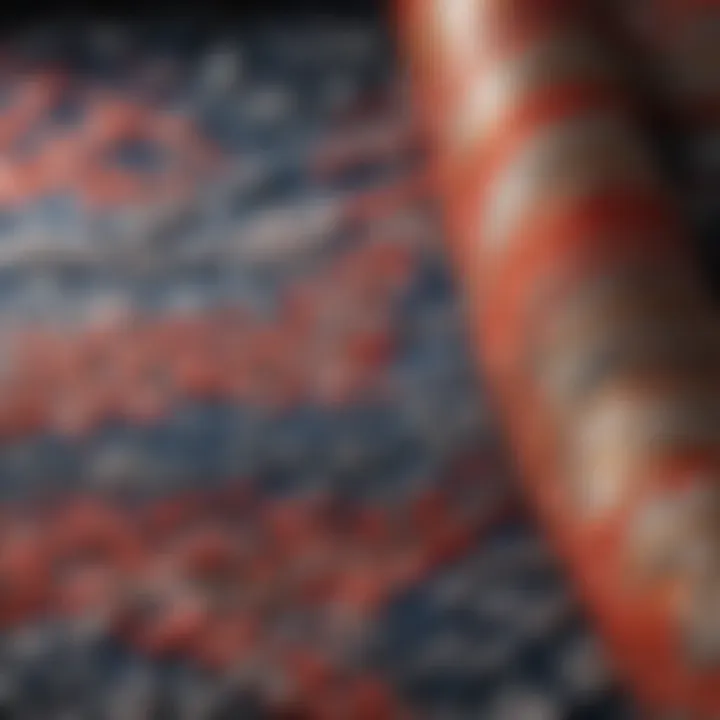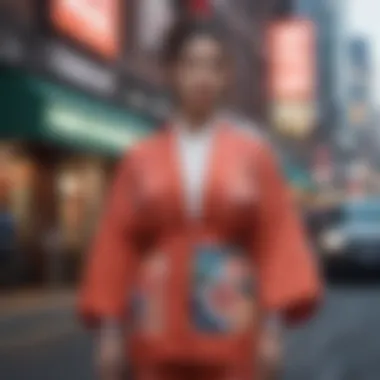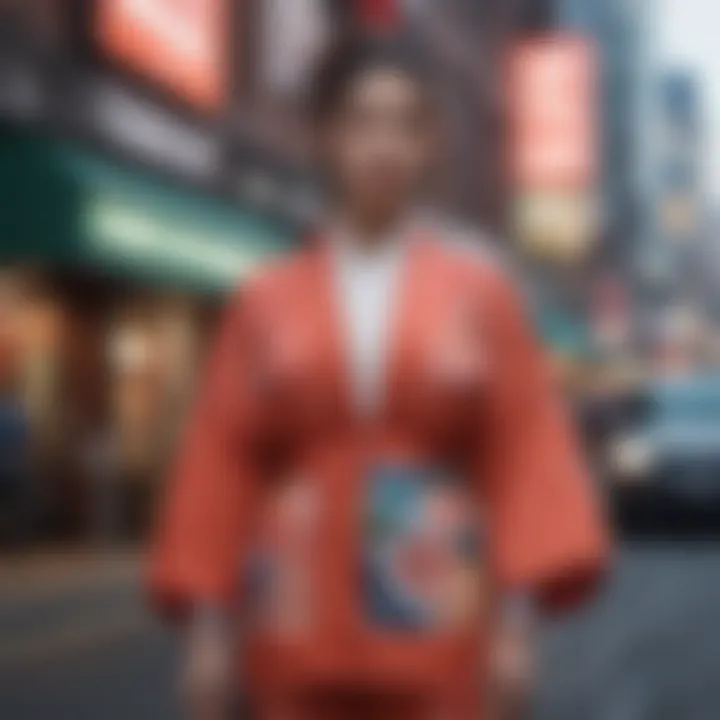Japanese Clothing Brands in the US: Style & Influence


Intro
Japanese clothing brands have carved a unique niche in the fashion landscape of the United States, making waves not just with their striking aesthetics but also with their underlying philosophies. The influence of these brands stretches beyond mere fabric and design; it's about a cultural exchange that transcends borders and resonates with a growing desire among consumers for sustainability and authenticity. As we uncover this intricate world, we will dissect how these brands manage to stay relevant by aligning their offerings with contemporary values while adhering to their rich heritage.
In this exploration, we'll delve into key trends shaping the industry, highlight influential brands, and discuss the sustainable practices that are becoming increasingly crucial in today’s fashion market. Whether you’re a seasoned fashion enthusiast or simply curious about the latest styles, this guide will illuminate the compelling presence of Japanese clothing brands in the U.S.
Key Trends
Overview of Current Fashion Trends
The realm of Japanese fashion has always been multifaceted. Currently, there’s a noticeable shift towards minimalism, often characterized by clean lines and neutral palettes. Brands like Muji epitomize this trend, focusing on functionality and simplicity over extravagance.
Moreover, the notion of "kawaii"—a cultural concept encompassing cuteness—still pervades many fashion labels, leading to playful and whimsical designs that attract a diverse audience. One can observe how brands like Sanrio, known for characters like Hello Kitty, have maintained their appeal through collaborations that infuse modern flair into traditional styles.
Popular Beauty Trends
Japanese beauty trends have similarly influenced the U.S. market. One notable trend is the focus on skincare as a foundational aspect of beauty routines. Brands such as Shiseido and SK-II have risen to prominence, showcasing the importance of quality ingredients and effective formulations.
Additionally, the adoption of layering in skincare regimens has become commonplace. This method involves applying products in a specific order to maximize efficacy. It's obvious that skincare isn't just a superficial endeavor anymore; it signifies a cultural shift toward self-care and personal well-being.
Sustainable Practices
Understanding Sustainable Fashion
Sustainability in fashion isn't merely a buzzword; it's a necessity, particularly in light of the environmental challenges we face today. Many Japanese clothing brands are ahead of the curve in integrating sustainable practices into their operations. Issey Miyake, for instance, employs innovative materials and techniques that reduce waste and environmental impact.
Moreover, the principles of traditional craftsmanship are intertwined with sustainable practices. Techniques such as upcycling and the use of organic materials reflect a deep respect for nature in the design process.
Tips for Sustainable Beauty
As consumers become more conscious about their choices, the transition to sustainable beauty products has gained momentum. Here are some tips to consider:
- Opt for products from brands that utilize biodegradable packaging, like Lush.
- Look for cruelty-free certifications to support ethical beauty.
- Embrace multi-use products to minimize waste and simplify your routine.
Foreword
Japanese clothing brands have carved a significant niche within the US fashion scene, often lauded for their intricate designs, unique aesthetics, and cultural influences. In exploring this topic, we uncover not just the styles and brands themselves, but also the attributes that make these garments sought after by many. The increasing fascination with Japanese fashion reflects a shift towards a deeper appreciation of craftsmanship, creativity, and authentic expressions of identity.
One of the notable considerations is the seamless blend of traditional and contemporary elements in Japanese clothing, which resonates well with a diverse audience in the US. Brands like Uniqlo and Comme des Garçons have successfully translated the ethos of Japanese fashion—minimalism, attention to detail, and utility—into items that are both trendy and accessible.
The benefits of acknowledging the presence of these brands in the US market are multifold. They not only contribute to a vibrant retail landscape, but they also encourage cross-cultural exchanges that enrich fashion dialogues across borders. The narrative of Japanese fashion in the US is woven with threads of innovation, sustainability, and distinct artistry, providing a foundation for understanding the ongoing evolution of global fashion trends.
The Growing Popularity of Japanese Fashion
In recent years, the surge of Japanese fashion in the US can be attributed to several key factors. Firstly, a rising consumer base seeks more than just clothes—they are after a psychological connection, a story encapsulated in the clothing. Brands like Issey Miyake emphasize narrative over mere aesthetics, drawing consumers who prefer meaningful purchases.
Additionally, in a world increasingly obsessed with fast fashion, the quality-centric approach of Japanese designers offers a refreshing alternative. This group of brands prioritizes craftsmanship over mass production, appealing to those looking for longevity and durability in their purchases. The popularity of layered looks and breathable fabrics found in these collections also contributes to their appeal in the fast-paced American lifestyle.
"The beauty of Japanese clothing often lies in its contradiction—minimal yet intricate, simple yet profound."
Moreover, social media platforms have played a substantial role in introducing Japanese fashion to a broader audience. From Instagram influencers boasting pieces from A Bathing Ape to YouTube channels dissecting the layered styles seen on Yohji Yamamoto runways, information travels fast and wide. With every post, the aesthetics of Japanese clothing seep into modern culture, leading to a redefinition of what constitutes style.
Cultural Influences on Fashion Trends
Cultural exchanges often serve as the lifeblood of fashion innovation. The influence of Japanese fashion on American trends speaks volumes about the intercultural dialogue taking place. For instance, the Japanese concept of 'wabi-sabi'—finding beauty in imperfection—carries significant weight in how brands design their offerings. This philosophy has found resonance in various American styles, promoting the idea that individuality and flaws can be celebrated rather than hidden.


The interaction between younger and older generations in both Japan and the US further enriches this dialogue. Through collaborations, such as those seen between established Japanese brands and American streetwear labels, a unique fusion emerges, pushing forward an expressive style that bridges gaps between cultures.
Collectors and enthusiasts often delve into vintage pieces that tell a story beyond mere fashion, showcasing how historical contexts influence present-day wear. This cultural appreciation encourages an awareness that contributes to not only fashion sense but also critical thinking about consumer habits.
While navigating through these layered meanings in Japanese fashion, one appreciates that it's not just about garments; it is about identity, emotional connection, and a broader narrative that speaks to human experience.
Key Japanese Clothing Brands Found in the US
Japanese clothing brands have made a significant mark on the fashion landscape in the United States, creating a captivating blend of unique aesthetics, functional design, and cultural storytelling. These brands not only cater to the diverse tastes of American consumers but also introduce concepts that often challenge conventional Western fashion norms. The importance of these brands in the article lies in the way they reflect both the global nature of fashion and the localized interpretations that resonate deeply with a broad audience.
Their presence in the US goes beyond merely selling clothes; it’s about embodying a philosophy that values craftsmanship, sustainability, and innovative design. By exploring these brands, readers can gain insight into the broader trends reshaping the global fashion narrative, especially the infusion of Eastern influences into Western styles that appeals to modern consumers seeking something distinctive.
Uniqlo: Mass Appeal and Quality
Uniqlo stands out as one of the most accessible Japanese brands in the US, offering apparel that prioritizes comfort and everyday usability. Founded in 1949, Uniqlo established itself in Japan before expanding globally, with its stores now dotting the American landscape. Its success stems from a simple philosophy: to provide high-quality clothing at fair prices. This commitment is evident in their use of innovative materials like HeatTech and AIRism, designed for various climates and day-to-day situations.
The brand caters to a broad demographic, crafting items that blend seamlessly into the average wardrobe. Men, women, and children can find something that resonates with their personal style, embracing the elements of simplicity and functionality that Japan is known for. The approach emphasizes a minimalistic design that doesn’t scream for attention but rather whispers of refined taste. A notable aspect is how the brand collaborates with high-profile designers to create limited collections, marrying luxury with affordability.
Issey Miyake: Innovative Textiles and Design
When one thinks of avant-garde fashion, Issey Miyake is likely to come to mind. Renowned for his experimental use of textiles and form, Miyake has shaped how the world perceives Japanese fashion since the 1970s. His designs often showcase remarkable innovation, such as the famous "Pleats Please" line, which introduced garments that combine both style and ease of care.
Miyake's approach revolves around technology and sustainability, looking to push boundaries not only in aesthetics but in the way fabrics are made. His work speaks to those who appreciate the artistry behind clothing, as well as the movement toward a more eco-conscious production model. The unique use of materials results in pieces that can be both sculptural and wearable, appealing to fashion enthusiasts who seek something more than mass-produced textiles.
Comme des Garçons: Avant-Garde Fashion
Comme des Garçons, founded by the visionary designer Rei Kawakubo, embodies the spirit of avant-garde fashion. Its presence in the US represents not just a brand but a movement that questions the norms of beauty and wearability. Known for distinctive silhouettes and a penchant for dark, often abstract, designs, the label has influenced countless other designers and fashion movements.
The pieces often evoke strong reactions; they tend to embrace the unconventional, encouraging wearers to express individuality boldly. Retail spaces like Dover Street Market, which features Comme des Garçons, underscore the brand's dedication to creating an experience rather than just a shopping venue. This focus creates a community around the brand, attracting those who are not just buying clothes but buying into a lifestyle that values uniqueness over conformity.
Yohji Yamamoto: A Tailored Aesthetic
Yohji Yamamoto’s contributions to fashion are nothing short of revolutionary. With a unique take on tailoring, his designs blend a traditional Japanese aesthetic with European sophistication. His collections often feature a palette dominated by black, showcasing the beauty of shapes and forms without the distraction of vibrant colors. This minimalist approach has garnered a loyal following that appreciates both the artistry and comfort of his garments.
Yamamoto's brand is closely linked to the idea of using fashion as a form of expression without sacrificing comfort. The flowing lines and distinctive cuts reflect a deep understanding of the human body, making his pieces both elegant and practical. As a prominent figure in the fashion world, his collaboration with brands like Adidas has also brought his unique vision to the realm of wearable sportswear, further bridging the gap between high fashion and everyday wear.
A Bathing Ape: Streetwear Culture
A Bathing Ape, commonly known as BAPE, has carved a niche in the urban fashion scene, particularly among younger audiences. Founded by Nigo in 1993, this streetwear brand has become associated with a lifestyle that emphasizes exclusivity and cultural relevance. The bold graphics, camo patterns, and vivid colors reflect the vibrancy of urban life, encapsulating a sense of rebellion and individuality.
The brand has gained a cult following partly due to its limited releases and collaborations with the likes of Kanye West and Pharrell Williams. BAPE's influence in the American market exemplifies how Japanese streetwear can shape global fashion trends. It shows how, through its unique approach, the brand draws from various cultural influences, creating a dialogue between Japanese aesthetics and urban American culture.
Design Philosophy of Japanese Brands
The design philosophy behind Japanese clothing brands is a nuanced and captivating subject that merits detailed exploration. It shapes not only the garments produced but also reflects cultural identity, respect for traditional craftsmanship, and an evolving understanding of modern consumer needs. With a strong focus on aesthetics, functionality, and sustainability, Japanese brands have garnered attention in the United States, appealing to a discerning audience that appreciates thoughtful design. The ethos of these brands emphasizes creating pieces that are not mere clothing but statements of quality and artistry.
This section delves into three pivotal aspects of the design philosophy of Japanese brands: craftsmanship, minimalism, and cultural symbolism. Each component contributes uniquely to the brands’ offerings, making them stand out in a crowded marketplace.
Emphasis on Craftsmanship
Craftsmanship in Japanese fashion is often regarded as a labor of love, embodying generations of techniques honed to perfection. Many Japanese clothing brands pride themselves on intricate details that are meticulously created, reflecting a deep respect for the art of making garments. This dedication can be seen in brands like Yohji Yamamoto, where every stitch tells a story of skill and precision.
"Quality is not an act, it is a habit."
This saying resonates profoundly within the ethos of Japanese craftsmanship.
Using premium materials, artisans often blend traditional practices with modern design philosophy. For instance, the use of natural fibers like indigo-dyed cotton, which is a hallmark of Japanese textiles, ensures durability while creating clothes that age beautifully.
Furthermore, workshops that focus on sustainable practices are increasingly prevalent among these brands. This sensitivity to environmental issues not only preserves the craft but aligns with rising consumer demand for eco-friendly production methods.


Minimalism and Functionality
Minimalism is a defining trait in the aesthetics of many Japanese clothing brands. It advocates for simplicity and elegance, often shedding the unnecessary frills that can clutter design. Uniqlo exemplifies this approach with its clean lines and functional wear.
This minimalist style is rooted in a unique philosophy called "wabi-sabi," which finds beauty in imperfection and transience. This outlook allows designers to create clothes that embrace modesty while remaining visually striking.
In addition, functionality is critical in Japanese design. Clothes are not just made for looks; they are crafted to fit seamlessly into the wearer's lifestyle. This practicality is apparent in the way garments often incorporate versatile elements, such as pockets in unexpected places or adjustable features that allow for adaptability.
Japanese brands epitomize the idea that fashion does not need to compromise on comfort or wearability. This marrying of minimalist ideals with functional design ultimately caters to a dynamic consumer base that values utility without sacrificing style.
Cultural Symbolism in Fashion
Cultural symbolism in Japanese clothing cannot be overlooked; it is woven into the very fabric of each piece. Much like brush strokes in a painting, clothing can carry messages, traditions, and ideologies. For example, traditional kimonos, with their rich colors and intricate patterns, often symbolize elements of nature or stories steeped in historical significance.
In contemporary fashion, brands like Comme des Garçons continuously push boundaries by infusing cultural ideals into modern silhouettes. The works of Riyoko Hoshi and others often evoke conversations about identity and perception, bridging past traditions with modern interpretations that speak to current societal themes.
Fashion thus serves as a canvas where designers express both personal and collective journeys. These stories resonate well with the American audience, introducing cultural narratives that go beyond surface-level understanding and fostering deeper appreciation for Japanese artistry.
Overall, the design philosophy of Japanese brands goes beyond fabric and thread; it reflects a tapestry of cultural narratives, craftsmanship, and a forward-thinking approach to fashion that resonates with consumers on many levels. As these values gain traction in the U.S., they continue to inspire a new generation of fashion enthusiasts who seek meaningful connections with their clothing.
The Role of Sustainability
Sustainability has become a buzzword in the fashion world, but its significance runs much deeper than mere marketing jargon. For Japanese clothing brands making their mark in the US, sustainability is a guiding principle that shapes their ethos and operational strategies. This commitment can be seen in several dimensions, particularly as it resonates with shifting consumer preferences and greater environmental awareness.
Eco-Friendly Practices Among Brands
Japanese brands are renowned not just for their innovative designs but also for their pioneering approaches to eco-friendliness. Companies like Uniqlo and Issey Miyake are integrating sustainable practices throughout their manufacturing processes. These brands are gradually employing recycled materials, which is an important step toward reducing textile waste. For instance, Uniqlo's Re.Uniqlo program accepts old clothing, allowing customers to gain a discount in exchange. This practice not only encourages recycling but also fosters brand loyalty by involving consumers in a community-focused initiative.
Many Japanese fashion houses are increasingly sourcing organic materials, such as cotton and linen, that minimize chemical use and land degradation. Brands like Muji take it a step further by emphasizing holistic sustainability; their products often come with a promise of environmentally friendly production methods from start to finish. In addition to that, several brands are committed to transparency, as they report their carbon footprints and the environmental impacts of their products, giving consumers more informed choices.
- Sustainable manufacturing: Shorter supply chains help in reducing carbon footprints.
- Ethical sourcing: Brands develop partnerships with suppliers who adhere to eco-friendly practices.
- Use of biodegradable materials: This reduces dependance on synthetic textiles that pollute the planet.
"In the world of fast fashion, choosing sustainable options might just be the ticket to leading a more responsible lifestyle."
Consumer Demand for Sustainable Fashion
Consumer demand for sustainable products is on the rise, driven by increased awareness of environmental issues. More than ever, shoppers want to align their purchases with their values. This shift in mindset is especially prevalent amongst younger generations who prioritize sustainability in their buying decisions. They are keen to support brands that embody ethical principles and environmental stewardship.
Listeners often tune in to brands that not only offer great designs but also have a positive impact on the planet. Japanese brands have tapped into this mindset by highlighting their sustainable attributes. Companies respond through marketing campaigns that emphasize their eco-conscious steps and often collaborate with environmental organizations.
Surveys suggest that consumers are willing to pay a premium for sustainable clothing, viewing it as an investment in lasting quality. The allure of unique designs combined with eco-friendly practices resonates particularly well with women of all ages; they not only favor style but also the underlying values behind each piece of clothing. These purchasing trends point to a broader evolution in the fashion industry, with sustainability at its core.
Impact of Japanese Fashion on US Trends
Japanese fashion has left a significant imprint on the U.S. landscape, one that resonates well beyond mere aesthetics. The influence of these brands goes hand-in-hand with a broader narrative about global culture, innovation, and an appreciation for craftsmanship. As American consumers grow increasingly discerning in their choices, they seek brands that reflect not just style, but a story. Japanese brands offer this, often encapsulating centuries of tradition within modern contexts.
The fusion of Eastern and Western aesthetics leads to a unique style that appeals to diverse consumer bases. It opens up a dialogue about identity and cultural appreciation, rather than cultural appropriation. Therefore, understanding the impact of Japanese clothing in the U.S. is essential not only for fashion enthusiasts but also for a broader audience interested in cultural narratives.
Fusion of Eastern and Western Styles
The blending of Eastern and Western styles has become paramount in shaping contemporary American fashion. Designers like Hiroshi Fujiwara often take inspiration from the street culture prevalent in Tokyo and translate it into something that resonates with the U.S. crowd. This cross-pollination allows for creativity to flourish in unexpected yet exciting ways. Unique silhouettes and unconventional layering techniques brought forth by Japanese designers often challenge Western notions of beauty.
In addition to aesthetic novelty, the cultural significance behind these designs is also important. It allows consumers to express themselves in ways that aren't just about following trends, but engaging with a story — their own story. This is important for buyers who want their fashion statements to articulate deeper cultural connections rather than just appearance.
"Fashion is not just what you wear; it’s a cultural statement that weaves together traditions, stories, and innovations."
Influence on Street Fashion


Street fashion in the U.S. has undeniably been shaped by Japanese designers. Brands like A Bathing Ape and Neighborhood have become household names and are often emulated by American streetwear enthusiasts. The bold graphics, vibrant colors, and innovative designs resonate with a youth culture that values individuality and self-expression.
Japanese streetwear doesn't merely follow trends; it sets them. These brands often employ limited releases and collaborations, creating an air of exclusivity that amplifies their allure. Furthermore, the DIY ethos popular in Japan emphasizes the importance of personal expression, encouraging wearers to reinterpret and customize their clothing. This approach has significantly influenced U.S. fashion, particularly within urban environments.
Challenges Facing Japanese Clothing Brands in the US
The landscape of fashion in the United States is as diverse as its population. Japanese clothing brands have made a notable imprint in this vibrant market, yet they face unique challenges that can hinder their growth and influence. Understanding these obstacles is essential, not just for the brands themselves, but also for consumers and industry watchers who appreciate the subtle intricacies of international fashion. Addressing these challenges could illuminate potential pathways for better integration and appreciation of Japanese styles in American wardrobes.
Market Saturation and Competition
As the saying goes, "too many cooks spoil the broth." This rings true in the fashion industry, particularly in the US where the market is swamped with diverse clothing brands vying for attention. For Japanese brands, which often leverage a niche appeal, this saturation can present significant challenges.
- Brand Recognition: With a plethora of options available, gaining visibility can be tough. Consumers might flock to more recognizable names, leaving lesser-known Japanese brands struggling for acknowledgment. For example, brands like Comme des Garçons and Issey Miyake stand out due to their innovative designs and established reputations. However, emerging brands still find it daunting to break through the clutter.
- Pricing Strategies: Japanese brands are frequently positioned in the premium segment. The competition from mass-market players can undercut prices, thereby affecting sales of higher-end products. Uniqlo succeeds by offering affordability, but that does not apply universally across all Japanese labels.
- Distribution Channels: Access to physical retail space is another hurdle. With the rising dominance of e-commerce, Japanese brands must also grapple with effective online marketing to foster consumer trust while navigating logistics across the ocean.
This saturation forces brands to reassess their unique selling propositions continuously, making it even harder to stand out.
Cultural Misunderstandings
Cultural nuances play an undeniable role in the perception of fashion. Unfortunately, many Japanese clothing brands may find themselves at a loss when it comes to effectively conveying their brand stories and designs to a largely Western audience.
- Misinterpretation of Aesthetics: Not every design translates seamlessly across cultures. The subtlety and often abstract nature of Japanese fashion can be misread or overlooked by those not attuned to its context.
- Fashion Language: Terms and concepts unique to Japanese fashion—like "Wabi-Sabi" or "Kawaii"—may not resonate with consumers unfamiliar with these ideas. This disconnect can hinder emotional engagement with brands, leading to a lukewarm reception.
- Brand Messaging: Some marketing strategies used in Japan may not align well with American values and expectations. A lack of alignment in messaging can lead to confusion, which damages the brand's reputation and trustworthiness in a new market.
"Cultural exchange is a two-way street; without an understanding of each side, the journey can falter."
In summary, the challenges facing Japanese clothing brands in the US are multifaceted and complex. Market saturation poses risks to brand visibility and consumer engagement, while cultural misunderstandings can stifle effective communication. Addressing these challenges calls for strategic innovation and adaptive marketing approaches that align with both brand ethos and local market expectations. Only then can these brands hope to weave their narrative into the rich tapestry of American fashion.
Future Trends in Japanese Fashion
Understanding the future trends in Japanese fashion is essential for discerning how this distinctive style continues to influence not just the American market, but also broader global fashion movements. The confluence of technology and evolving consumer preferences shapes these trends, driving innovation and redefining the essence of clothing in a rapidly changing world. This section delves into these elements, examining their benefits and the profound implications for Japanese brands operating in the US.
Technological Integration in Fashion
The marriage of technology and fashion has laid a new foundation for creativity and functionality. Japanese brands are at the forefront of this fusion, embracing advancements that enhance both design and user experience. Think of brands like Uniqlo, which utilize technology-driven materials for a comfortable, breathable experience. This isn't just about style; it fosters a deep connection between the consumer and the product.
Innovations like smart textiles or temperature-regulating fabrics are pushing the envelope. Imagine garments that adjust to the wearer��’s body temperature or connectivity features that allow garments to sync with smart devices. These technologies provide consumers with added value, enhancing their experiences and further justifying the investment in quality Japanese brands.
Additionally, technological integration streamlines manufacture processes. 3D printing, for instance, enables companies to create intricate designs with fewer resources, minimizing waste. This not only aligns with sustainable practices but also appeals to environmentally conscious consumers eager to support brands committed to responsible fashion.
Evolving Consumer Preferences
The landscape of consumer tastes is shifting, and it’s driven by a myriad of factors including global trends, cultural discussions, and individual expression. Today's shoppers crave authenticity and are particularly drawn to brands that reflect their values, from sustainability to ethical labor practices. Japanese clothing brands, with their innate cultural emphasis on craftsmanship, resonate well with this desire for meaningful connections.
Moreover, there is a rising trend towards personalization in fashion. Consumers are no longer satisfied with merely purchasing an item; they are on the lookout for unique pieces that speak to their individuality. Brands that offer customizable options or inclusive sizing show an understanding of this demand.
In a sector where instant gratification reigns, adapting to online shopping trends is critical. Japanese brands are increasingly investing in e-commerce platforms, ensuring they remain accessible and engaging across digital channels. This shift also means that cataloging unique pieces and using social media for outreach becomes paramount. A focused strategy that caters to these consumer habits can elevate the presence of Japanese brands in competitive markets.
"The future of fashion lies in its ability to adapt and respond to the changing whims and wishes of consumers, particularly when those consumers are becoming actively engaged in the narrative of what they wear."
As these trends materialize, they not only pave the way for Japanese brands to thrive but also set the stage for a revitalized appreciation of fashion that marries artistry with functionality. Thus, the significance of tracking these trends cannot be understated, as they represent the dynamic and shifting scope of cultural expression in clothing.
Epilogue
As we draw the curtain on our exploration of Japanese clothing brands in the US, it becomes clear that these brands are more than just purveyors of fashionable attire. They embody a distinct approach to design and a unique aesthetic that has resonated deeply with American consumers. The enduring legacy of these brands speaks volumes about the rich tapestry of cultural interaction, craftsmanship, and transformative trends shaping the fashion landscape.
The Enduring Legacy of Japanese Brands
Japanese clothing brands have carved a niche within the US market, influencing not just the styles we wear but also the values we attach to fashion. A few key elements shape this legacy:
- Innovative Design: Brands like Issey Miyake and Comme des Garçons have continually pushed boundaries. Their commitment to avant-garde fashion and innovative textiles has sparked admiration and imitation alike.
- Cultural Exchange: The blend of traditional Japanese aesthetics and contemporary Western influences has resulted in a unique fusion that appeals broadly to diverse demographics. This exchange elevates clothing from mere fabric to cultural narrative.
- Sustainability Movement: Brands have embraced eco-friendly practices, appealing to the growing demand from consumers for sustainable options. This focus positions them as leaders in the realm of responsible fashion.
"Japanese fashion is not just about clothing; it's a philosophy that intertwines art, function, and identity."
- Impact on Streetwear: With companies like A Bathing Ape, we've seen an explosion of creativity in street fashion that resonates particularly with younger generations seeking uniqueness and self-expression.
- Craftsmanship: The meticulous attention to detail and craftsmanship found in Japanese brands is unparalleled, setting a gold standard that many aspire to but few achieve. This dedication enhances the perceived value of their products.



